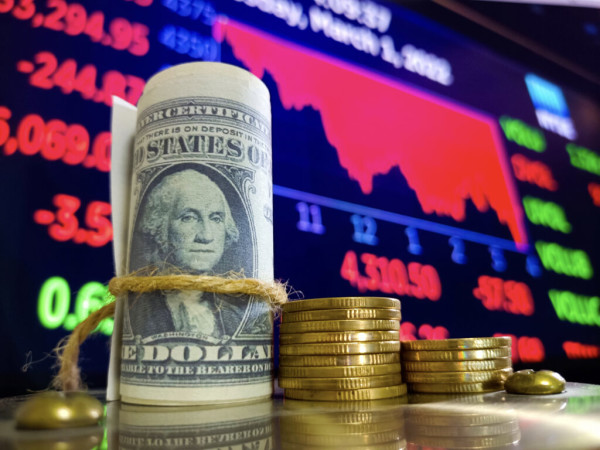Investment outlook 2023: things likely to get worse before they get better

Equity markets could be in for a rough ride this year, although there are opportunities in fixed income and alternatives
Persistently high inflation, fuelled by energy price surges triggered by Russia’s war against Ukraine, aggressive central bank tightening and slowing economic growth, compounded by China’s zero-Covid policy, made 2022 a challenging year for investors.
Last year, both equity and fixed income markets delivered negative returns, a combination which had previously occurred just twice in the past 100 years – in 1931 and 1969 – according to Lombard Odier. As a result, the traditional balanced 60/40 portfolio – 60 per cent stocks and 40 per cent bonds – which served investors well for the past 50 years, came under fire.
“What a year like 2022 teaches us is that it is very important to have diversification in your multi-asset portfolio, it's not all about bonds and equities,” says Lombard Odier’s CIO Stéphane Monier. Alternatives, and hedge funds especially, helped reduce losses, with macro-trends and CTAs among the few assets delivering positive performance last year.
With the global economy expected to get worse before recovering, asset allocators are entering the new year with a defensive stance in client portfolios, expecting 2023 to be the year of the pivot. “So far this decade, we have had the year of infection, the year of injection and the year of inflation. We think 2023 will be the year of inflections,” says Mark Haefele, CIO at UBS GWM, the world’s largest wealth manager.
“Whether you look at inflation, interest rates, economic growth or geopolitics, the year ahead is going to be defined by these turning points. And identifying the timing and magnitude of these inflections is going to be key to navigating the environment,” he adds.
With most central banks expected to finish their hiking cycle around the first quarter, UBS predicts a trough in global economic activity likely to occur around the middle of the year, as lower inflation and higher real wage growth, the winding down of China’s zero-Covid policy and the end of the cold weather in Europe supporting economies. This means there is a “good chance” equities take “another dip” as earnings respond to slower growth.
UBS begins 2023 with a defensive tilt to equities, a quality bias in fixed income and a view that the dollar will remain strong, believing the backdrop may start to get more favourable as the year evolves. “We don’t think markets are fully reflecting the likely impact of tighter monetary policy on economic growth and earnings,” says UBS GWM’s Emea CIO, Themis Themistocleous.
The search for “resilience” drives the global bank to favour sectors such as consumer staples and healthcare, which historically have outperformed in periods of market volatility, and are expected to be among the few sectors delivering positive earnings growth this year.
The global bank continues to prefer value equities, which have tended to outperform growth stocks in periods of inflation higher than 3 per cent. “With inflation likely to stay high, value looks good. And within value, energy stocks remain the focus for us,” states Mr Themistocleous.
While the energy sector was the key driver of outperformance last year, energy stocks remain attractive, with valuations trading at 50 per cent discount to the global index and oil prices expected to stay “higher for longer”.
Bonds are back
The fastest rise in interest rates in 25 years has driven the biggest fixed income sell-off in in history, bringing bonds back onto wealth managers’ radar screens.
“What we have experienced in fixed income, following the continuous hawkish views of central banks, has been significantly lengthier and deeper than many other financial crises we've experienced in the past,” says Deutsche Bank’s Emea CIO, Zeynep Ozturk. “Now the tide is about to turn,” she adds, believing 2023 is opening fresh yield opportunities.
The concept that ‘there is no alternative’ to stocks, also known as ‘Tina’, which led investors to pile into equities as interest rates reached ultra-low or negative levels, does not hold anymore. “There is now a clear alternative to equities, which is fixed income assets,” stresses Credit Suisse’s global CIO, Michael Strobaek, pointing to a 10-year US Treasury yield of around 4 per cent. “Bonds are coming back, and their key role is to be hedges in portfolios, in a slow growth or even recessionary environment.”
While bond markets have already sharply corrected, equity markets are not yet “fully discounted”, believes Mr Strobaek. If the Fed wants to reduce inflation, it will have to hurt the economy and reduce employment, and earnings need to slow down, he says, expecting the Fed’s terminal rate to reach around 5 per cent this year.
While inflation will eventually decline during 2023, it will stay “well above” the 2 per cent target of the past, with interest rates also at “elevated levels”, representing a “game changer” for equity markets, he says.
“This is a fundamental regime shift, as central banks are no longer on the side of investors,” adds Mr Strobaek, warning markets will be deluding themselves if they believe any marginally lower inflation number may drive central banks to fast pivot and cut rates. Credit Suisse has been tactically underweight equities in its multi-asset portfolios since last August.
Year of two halves
The year ahead will be one of two halves, believes Daniele Antonucci, chief economist at Quintet Private Bank, as central banks will continue hiking interest rates, although more gradually, before stopping in the spring. Inflation will visibly ease, and a new cycle of global growth will begin, supported by Chinese acceleration. The recovery will be uneven, though, with Europe and the UK lagging the US, and developed markets growing more slowly than emerging ones.
Investors should keep an underweight exposure to equities, still expensive when compared to risk-free bonds, but not “re-risk” or “de-risk” portfolios further. Instead, according to Quintet, they should opt for high dividend and low volatility stocks, which provide protection in downside scenarios and, in some cases, “attractive growth potential”.
The Luxembourg-based firm prefers the more expensive but higher quality US equity market, while being more cautious on eurozone equities, with the continent at risk of a deeper recession, resulting mainly from the energy crisis. Emerging market stocks, on the other hand, are believed to be attractively valued and are likely to benefit from China’s reopening.
Quintet also focuses on “quality assets” in the fixed income space. “While 2023 promises continued volatility, high-quality bond markets, and especially government bonds, should once again provide defensive benefits, reducing portfolio risk,” says Mr Antonucci.
An inflection point, which will be important to time correctly in 2023, will determine a shift from a “prudent” to more “aggressive” approach at Lombard Odier. “After the pivot and peak in real US rates, we will move from investment grade into high yield,” states Mr Monier. As economic conditions worsen, defaults resulting from widening credit spreads will “deeply penalise” high yield bonds.
The attractiveness of equities will increase during the year, he adds, while appetite for gold will grow, as pressure from US dollar appreciation fades away. This weakening of the dollar will also make emerging markets “interesting to own”, both debt in local currency and equities.
Despite its underweight in risk assets, the Swiss bank currently overweights Chinese stocks, convinced the country’s economy is well supported both on the monetary and fiscal policy side.
It is “imperative” for Chinese authorities to return to their 4 per cent economic growth target this year, which ensures full employment in the country and keeps social discontent at bay, adds Lombard Odier’s chief economist Samy Chaar. Even if Covid cases boom, fatalities increase and pressure on the hospital system grows, China’s reopening will continue regardless, he believes.
Lombard Odier enters the year with an outsized exposure to cash and fixed income, mainly government bonds and investment grade credit, as well as alternatives. Currency wise, it prefers the US dollar and Swiss franc, over the renminbi and euro.
Long-term appeal
A key downside risk for investors to watch in 2023 is a policy mistake or central bank-induced sharp recession, according to asset allocators, while Russia’s war against Ukraine will continue to be a source of volatility.
“Unfortunately, I don't think a diplomatic solution can be found in the very short run, as there is too much at stake on both sides,” says Lombard Odier’s Mr Monier, expecting the conflict to be a long one. Mr Putin’s strategy will be to continue to deploy new troops in Ukrainian territory and overwhelm Ukrainian forces, even if these are better armed, he adds, believing the Kremlin has not given up on its objective to take Kyiv.
Despite uncertainty in the short term, the longer-term outlook is more appealing for diversified investors. Given current stock valuations, UBS predicts equities will deliver 8 to 10 per cent annual returns over the next 10 years, while higher bond yields are consistent with higher returns in fixed income assets.
Within alternatives, hedge funds and private markets will benefit from low valuations and stronger returns in underlying assets. Overall, commentators are predicting a healthier return from private portfolios, with the wider range of available assets providing an added bonus.



